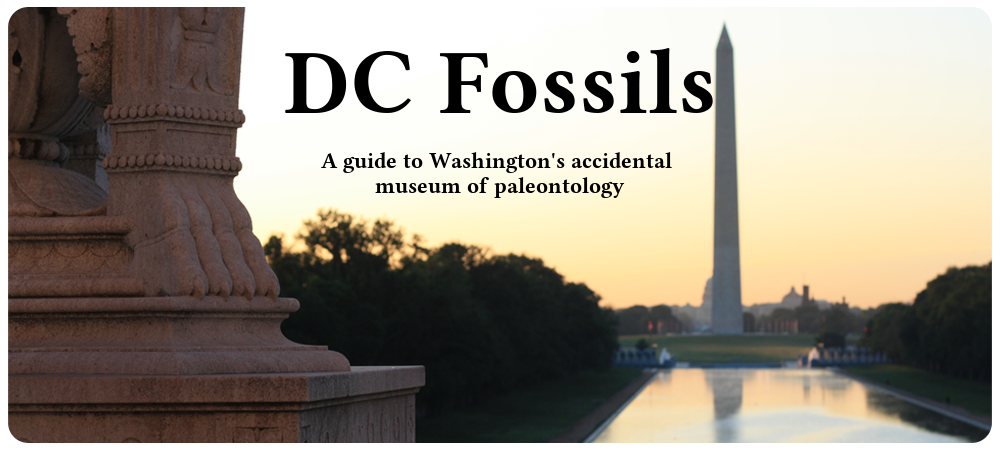Introduction
Fossils of the Holston Formation
About Nautiloids
The Holston Formation’s Paleoecology and Use as a Building Stone
Mississippian Fossils Introduction
The Fossils
Nature and Paleoenvironment of the Bangor Limestone
Limestone Identification in Blue and Gray
Ordovician Fossils
Acknowledgments and Sources
Introduction
Millions of visitors each year stream through the National Gallery of Art’s West Wing, on the north side of the Mall between 3rd and 7th St., N.W.:

Many doubtless believe that they are entering a Smithsonian museum, but they are not. The National Gallery of Art is an independent, federally-operated museum. It exists because of a single citizen’s vast donation to the U.S. government. Paul Mellon, a public figure with great wealth and an extraordinary private art collection, donated the money to build the Gallery, as well as his own art collection to serve as the core of the new, national art museum.
To house this first national museum devoted solely to art works, the noted architect John Russell Pope designed what has been described as “one last monument” to Classicism. Pope designed the Gallery to satisfy the need of Americans for “buildings more sumptuous, more spacious, and less utilitarian than their everyday surroundings,” as John Walker has phrased it.
A visitor at the center of the main floor stands under a high dome modeled after the Pantheon, held up by two dozen massive columns. A classical statue of Mercury tops a central fountain, and vast expanses of hall extend nearly 400 feet in either direction.
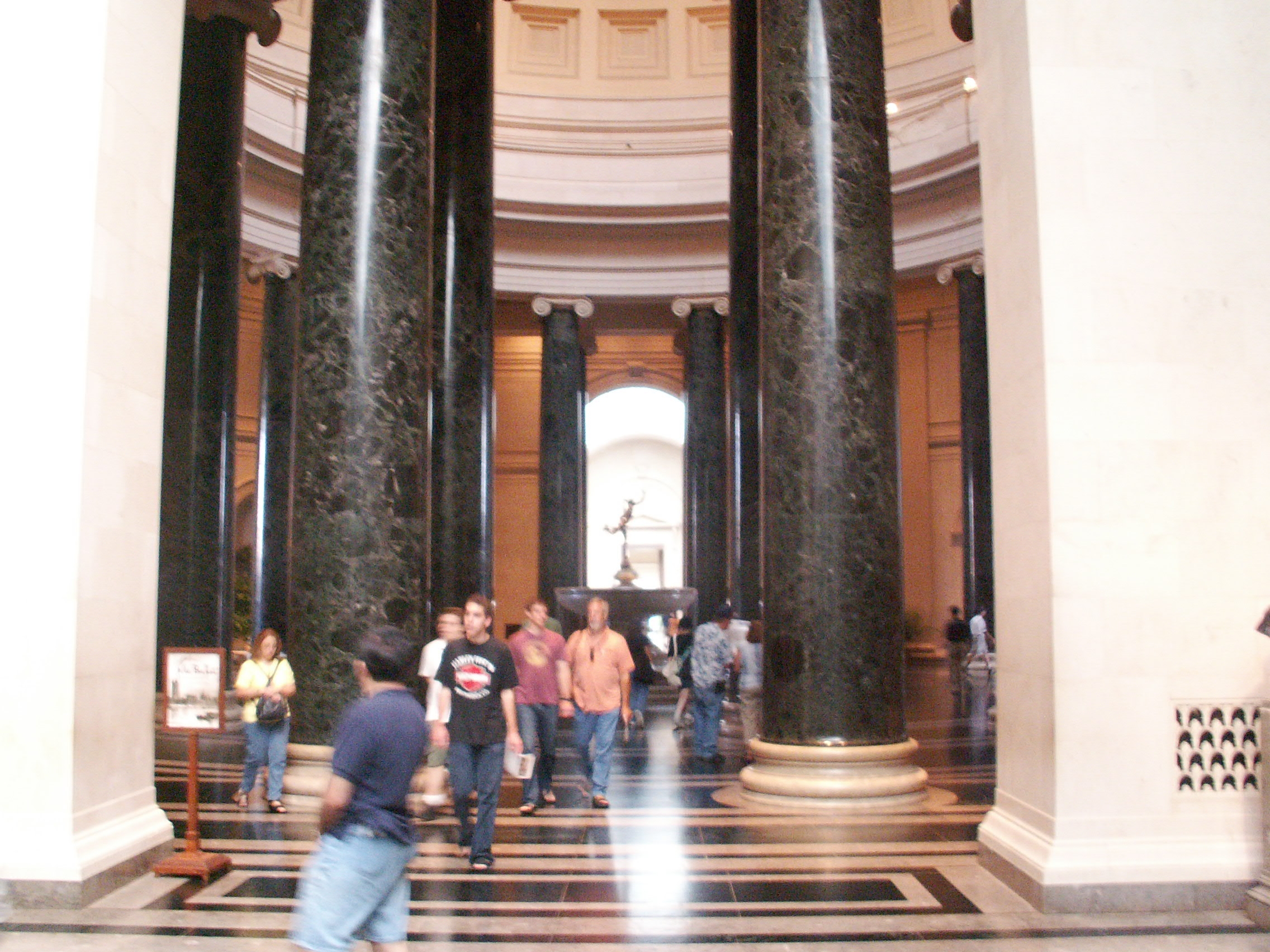
Marbles, limestones and granites from 40 different quarries line the floors, walls and columns. The architect sought to ensure that the visitor would “receive great pleasure from the National Gallery simply as architecture” (quoted from John Walker). This goal departed greatly from the architectural school, influential both then and now, that believed the museum building should not distract visitors from the art works.
When the museum opened, however, the attractions of the building itself were of some importance. Mellon’s collection required only a small portion of the building’s vast display space, and visitors had ample opportunity to study the architecture rather than the art. Today, the building’s galleries are full, but the visitor can still have an interesting visit observing the structure itself.
Beyond even the expectation of Mr. Pope, the visitor can also “receive great pleasure” from an entirely different aspect of the Gallery: its rich expanse of paleontological exhibits. No less than three different types of fossil-bearing stones appear within the Gallery – a seemingly unintended result of the architect’s desire to achieve a “sumptuous appearance.” The Gallery presents in effect a Paleozoic menagerie that can be visited on its own account, or viewed as a change of pace from the displays of the Dutch Masters and Italian Renaissance.
Fossils of the Holston Formation
From the central rotunda, only a few steps lead to the National Gallery of Art’s “Gallery 1,” home to “Italian Gothic Painting and Sculptures, 1270-1360’” In particular, take a moment to admire the vividly colored tempura on panel “Madonna and Child with Saint Peter and St. John the Evangelist,” by Nardo di Cione (c. 1360). Then, look down at the floor, to the left and near the room’s corner. The gray/pink stone border contains a coiled shell:
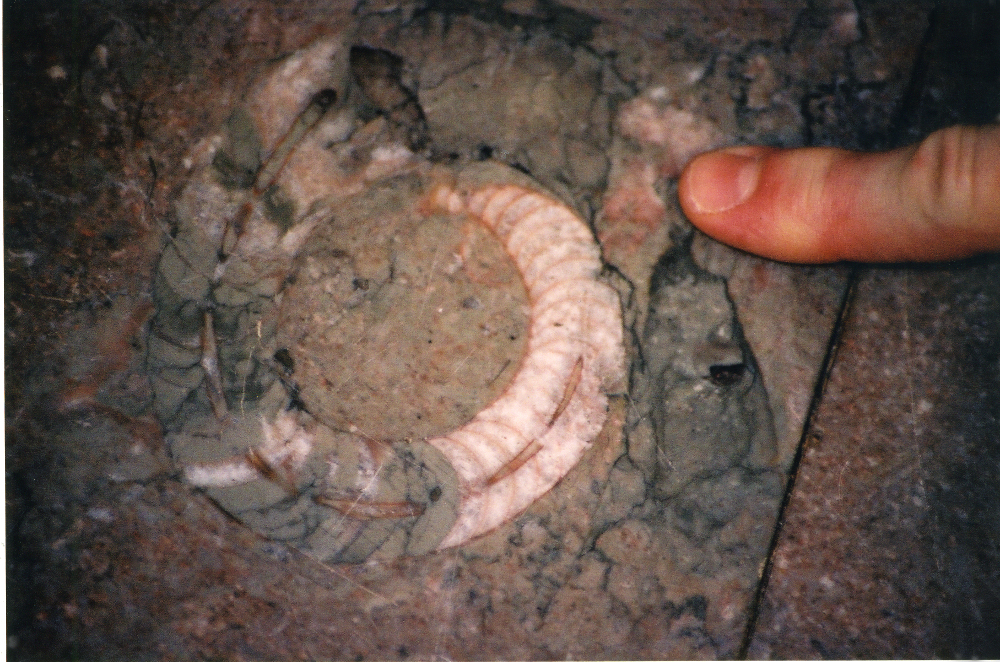
Nearby and further to the left is a similar but straight-shelled fossil. They are fossils of marine animals known as nautiloids. Even a casual look will reveal others in this room alone:
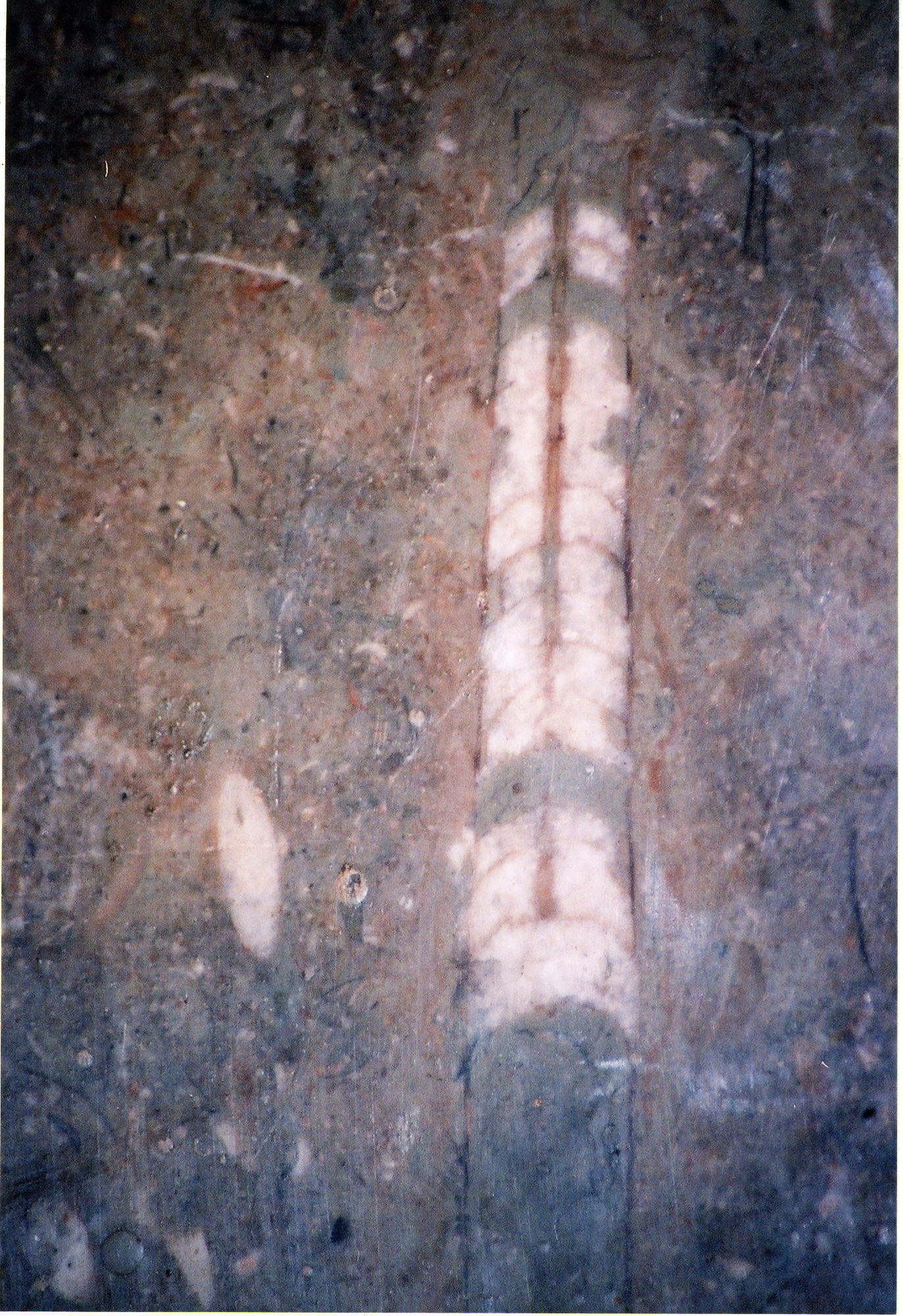
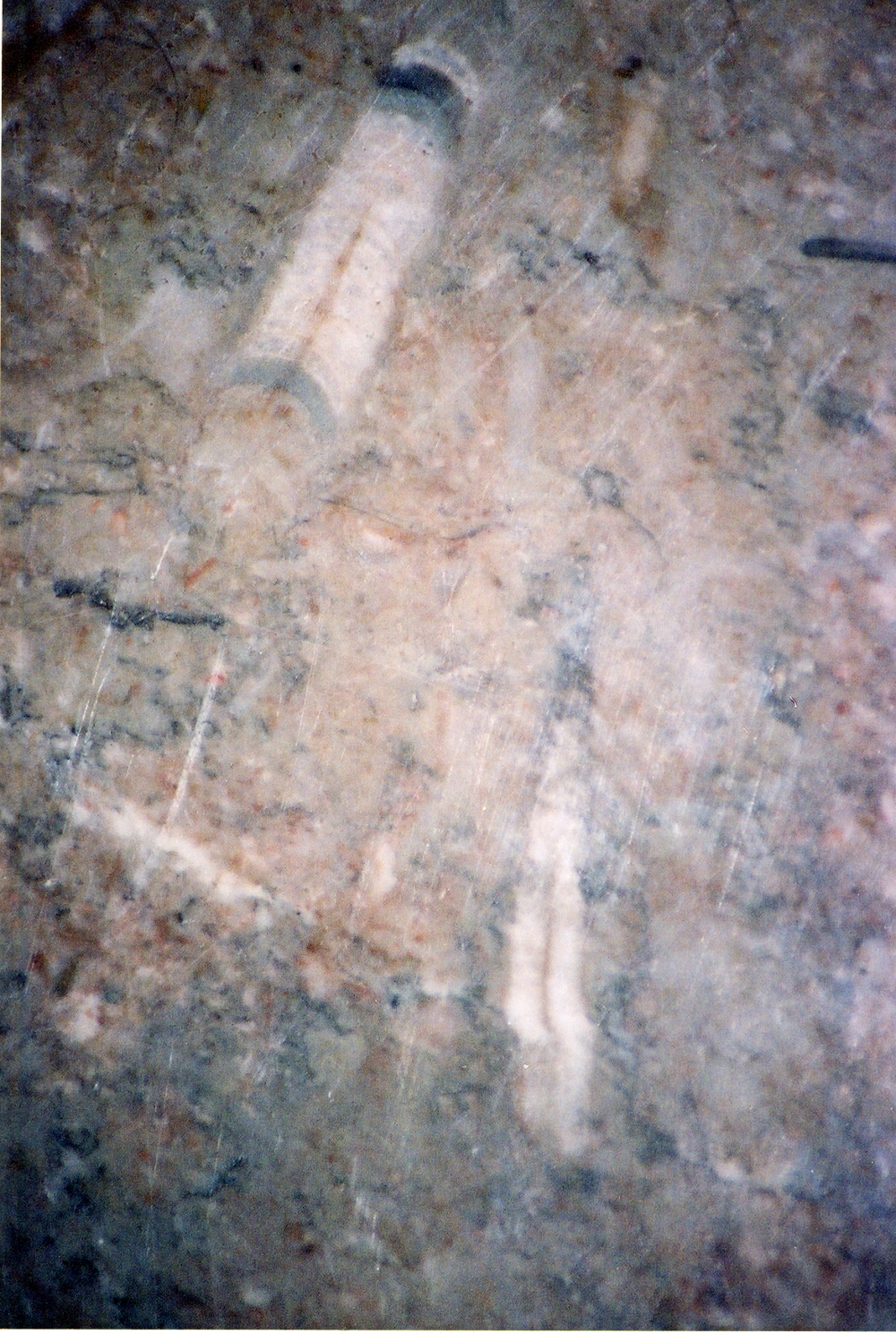
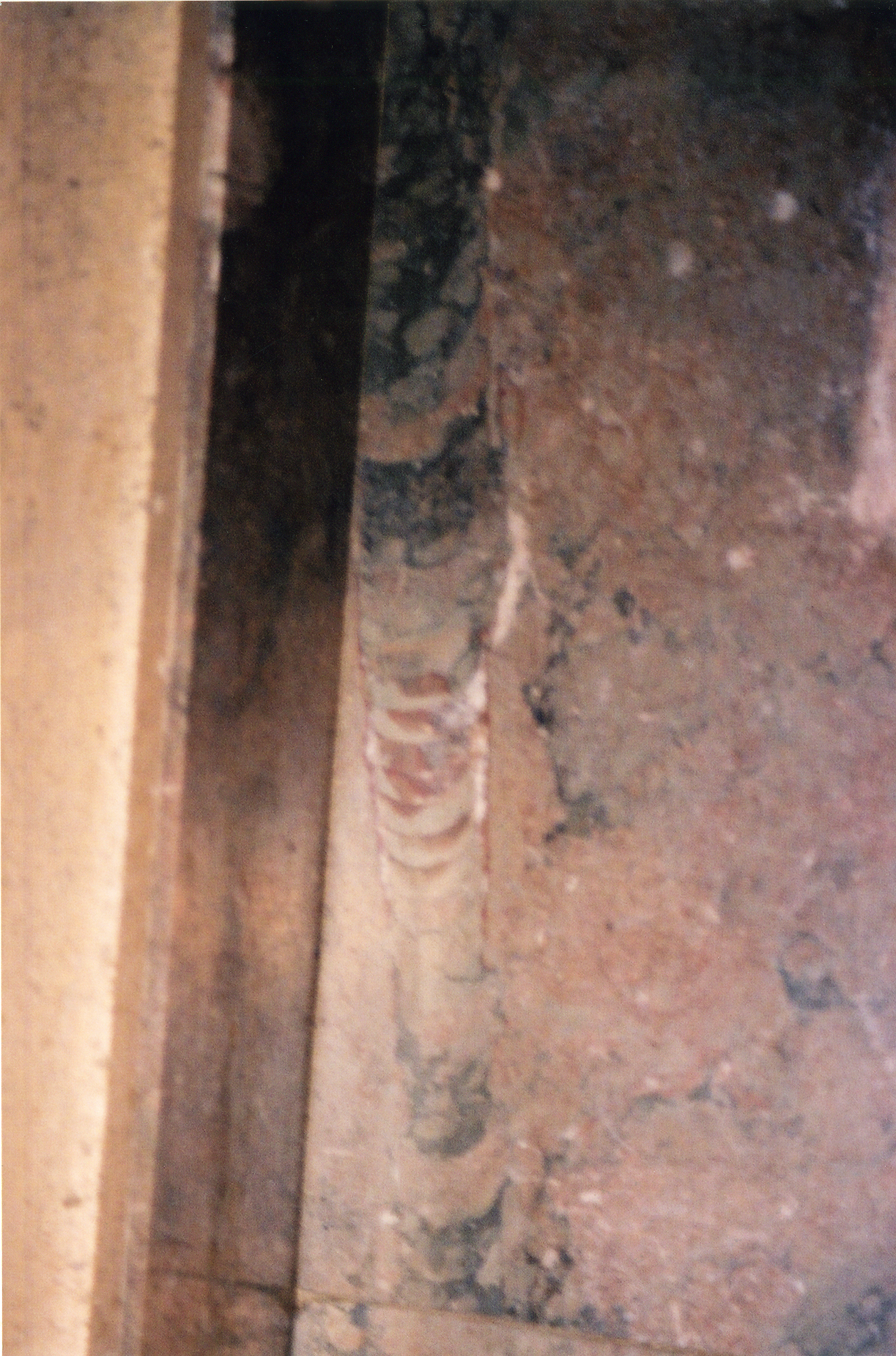
The fossil-bearing rock is a limestone known as “Tennessee Marble,” from the Holston Formation of Tennessee state. Stone from the Holston Formation appears throughout the main floor of the museum, chiefly in narrow lines bordering the galleries. Sometimes the fossils are faded, but still discernible:
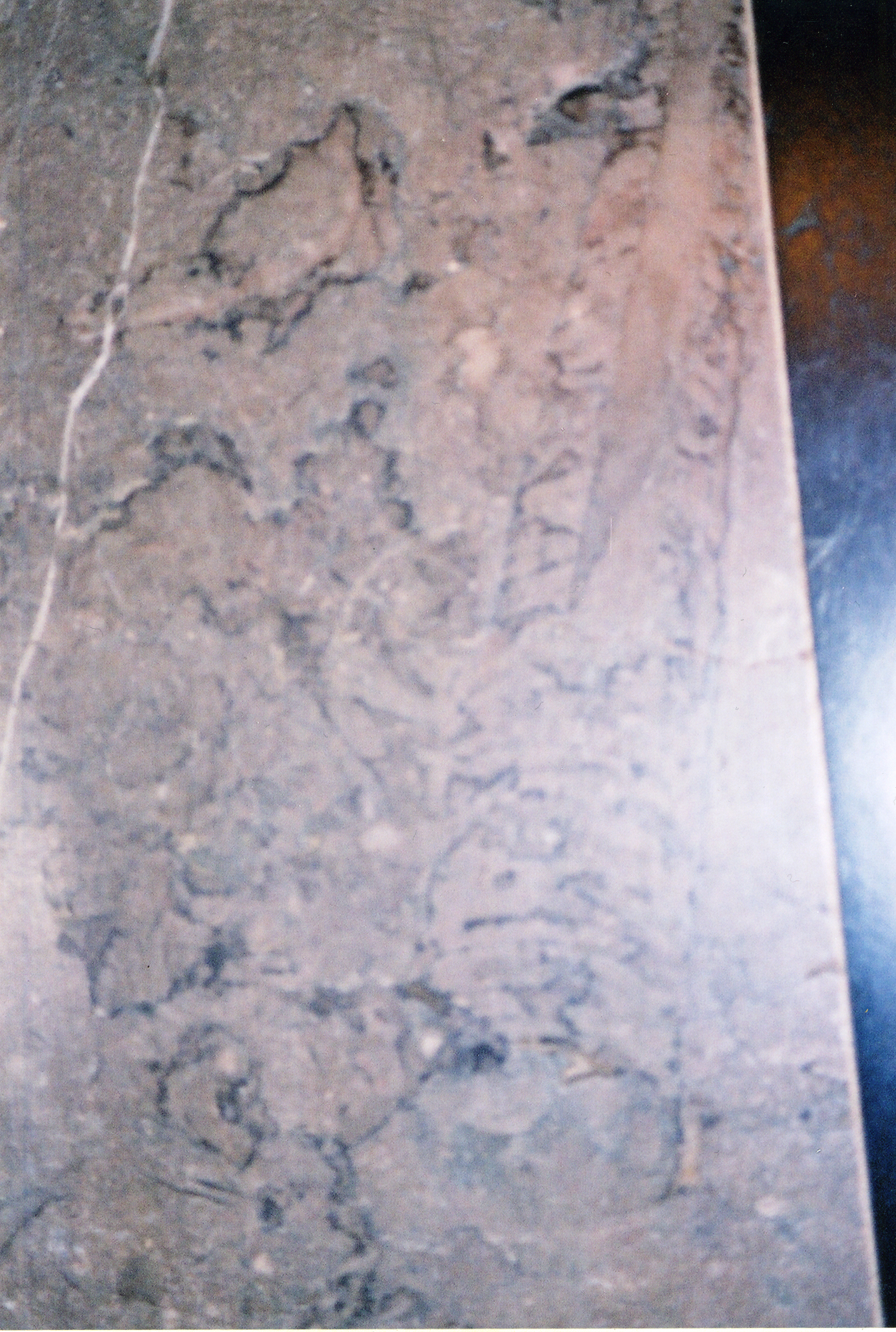
Although its most visible fossils are numerous, large nautiloids, the Holston stone is entirely composed of a mass of tiny skeletal fragments. Visitors to the museum walk from exhibit to exhibit over the fossil remains of creatures from an Ordovician reef-like environment that existed in a shallow sea about 450 million years ago. The nautiloids are merely the most easily discerned with the unaided eye.
About Nautiloids
Identity
The conical fossils are cephalopod nautiloids, a nearly extinct Mollusc subgroup whose members were distant relatives of modern day cephalopods such as octopi, squids, cuttlefish and the chambered nautilus. Many of these specimens appear to be Endoceras, although a number of different types are probably represented.
Rise and decline
Nautiloids appeared during the Cambrian period, more than 500 million years ago and became numerous and geographically widespread during the Ordovician, the time period in which the nautiloids of the Holston Formation lived. During the Ordovician, some Nautiloid species were among the largest animals on earth – some had shells 30 feet long. (The Holston Formation has produced nautiloid shells of at least seven feet in length.) Nautiloids flourished until the later Paleozoic, but dwindled until the last of the orthoconic (straight-shelled) nautiloids became extinct during the Cretaceous. Today, only two related genera survive in the Southwest Pacific: the coiled chambered Nautilus and Allonautilus.
Anatomy
As the fossils show, nautiloids had long, narrow and conical shells divided into a series of chambers separated by walls (septa). The nautiloid’s body occupied the last and largest chamber at the open end of the shell. As nautiloids grew, they periodically moved the soft tissue forward, building an additional chamber behind. The rest of the shell was linked to the body in front by a tube known as the “siphuncle,” filled with veins and arteries. The siphuncle is visible in some of the fossils as a line running down the middle of the shell. Like modern cephalopods, the nautiloids probably possessed a number of tentacles (but without suction pads), eyes with slits ending in pinholes, a sophisticated nervous system, probably jaws with a parrot-like beak, and a tough hood that could cover the opening of the shell to protect the soft body and tentacles when they were pulled into the shell. A diagram of a nautiloid appears at http://www.tonmo.com/science/fossils/nautiloids.php. A diorama re-creating an Ordovician nautiloid can be seen in the Smithsonian’s National Museum of Natural History:
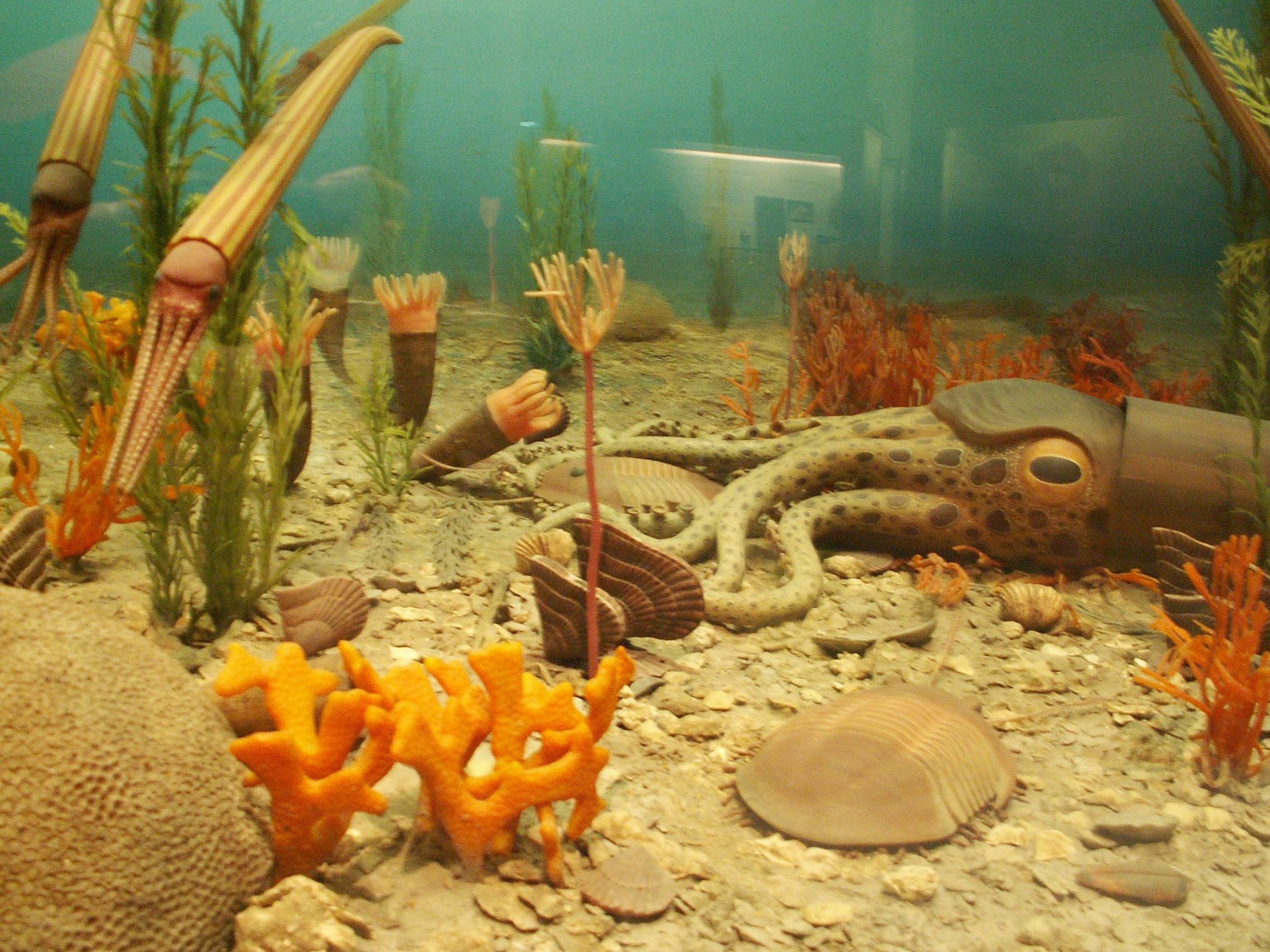
Life habits
Nautiloids were free-swimming predators and scavengers that moved by squirting jets of water, like modern squids. They floated while they swam, supported by the buoyancy of the gas-filled chambers of their shells – buoyancy controlled by the action by the siphuncle, which removed liquid from newly formed chambers and the empty space filled with a mixture of gasses. The greater the number of chambers offset the increased weight of the animal caused by growth of the soft tissue body, allowing the nautiloid to move freely at essentially neutral buoyancy using its jet propulsion system. Some nautiloids displayed patterns of stripes, zigzags and bands on their shell’s upper side. It is likely that these patterns were colored in life, providing a clue that the nautiloids swam in horizontal position, with patterns visible as camouflage from predators above, and a white shade from below. They preyed on other animals, likely including reef inhabitants, primitive fish, swimming, floating and crawling invertebrates – and other nautiloids.
The Holston Formation’s Paleoecology and Use as a Building Stone
Paleoenvironment
During the middle Ordovician, about 450 million years ago, a shallow body of water extended over approximately 2500 square miles of eastern Tennessee, bordered by low-lying land masses to the northwest and southeast, opening out to a larger body of water to the southwest. The identity and condition of the fossils suggest that the water was shallow. The majority of the nearly 60 animal species found in this formation were various types of bryozoans (see description in Gallery 6), although they include crinoids and nautiloids, and more infrequently, brachiopods, pelecypods and gastropods. Their shells and skeletal remains are mostly broken and scattered in what appears to have been a “high energy environment” (i.e., active currents and even waves). Thin sections (enlarged views of microscopic structures) from the formation illustrate a rich diversity of fossil fragments that are not visible to the unaided eye.
It appears that over time, mounds of their skeletal remains formed, resembling in some respects modern reef – sometimes even breaking the surface of the water. Periodically, fine clay from the land nearby appears interleaved with the fossil beds, possibly deposited by dust storms. Eventually, the loose masses of skeletal remains were compacted under the weight of newer layers. Pores between the remains were cemented by calcium-rich mud. Much later still, sediments of clay and gravel deposited above compacted the entire mass into a more crystalline structure, dense and hard. Over many millions of years, these deposits were first buried deep, then uplifted and folded by geologic processes. The crests of the folds were then exposed over time, as erosion removed the overlying strata from the crests of the folds.
Holston Formation’s role in providing building stones
In the rugged hills of eastern Tennessee, outside Knoxville, the Holston Formation outcrops in long, narrow belts. The formation varies in thickness, ranging to as much as 400 feet deep, although only about 60 to 80 feet are workable. The location of these belts is illustrated below:
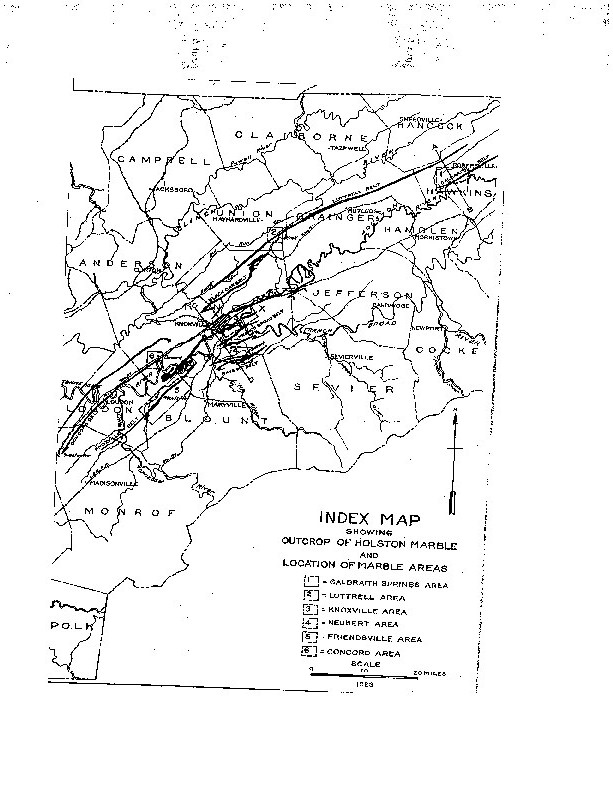
Source: p. 27, Bulletin 28, Marble Deposits of East Tennessee, Tennessee Division of Geology.
The exposed stone contains a variety of colors, including, in the words of the Tennessee Division of Geology, “[g]rey (light and medium), faintly pinkish gray; pink (light, medium, deep); dark reddish-purplish (chocolate color); mixed gray and reddish or pinkish,” as well as “transitions from the deep pink to chocolate color.” Other places in Washington display Tennessee Marble, but none appear to provide the fossil display found in the National Gallery of Art.
Mississippian Fossils
Introduction
The next fossil display in this museum is more elusive. To view an excellent exhibit, first proceed to the West Sculpture Hall, the long, high and largely empty chamber stretching west of the Rotunda. On the north side, between Galleries 4 and 7, you will find a bronze bust of the Emperor Hadrian (by Ludovico Lombardo, c.1550). The bust is an interesting piece, but another, and very different, exhibit can be found in the white stone wall behind it. Walk about nine feet to the left, and examine the wall slightly less than six feet off the ground. There you will see a large fossil:
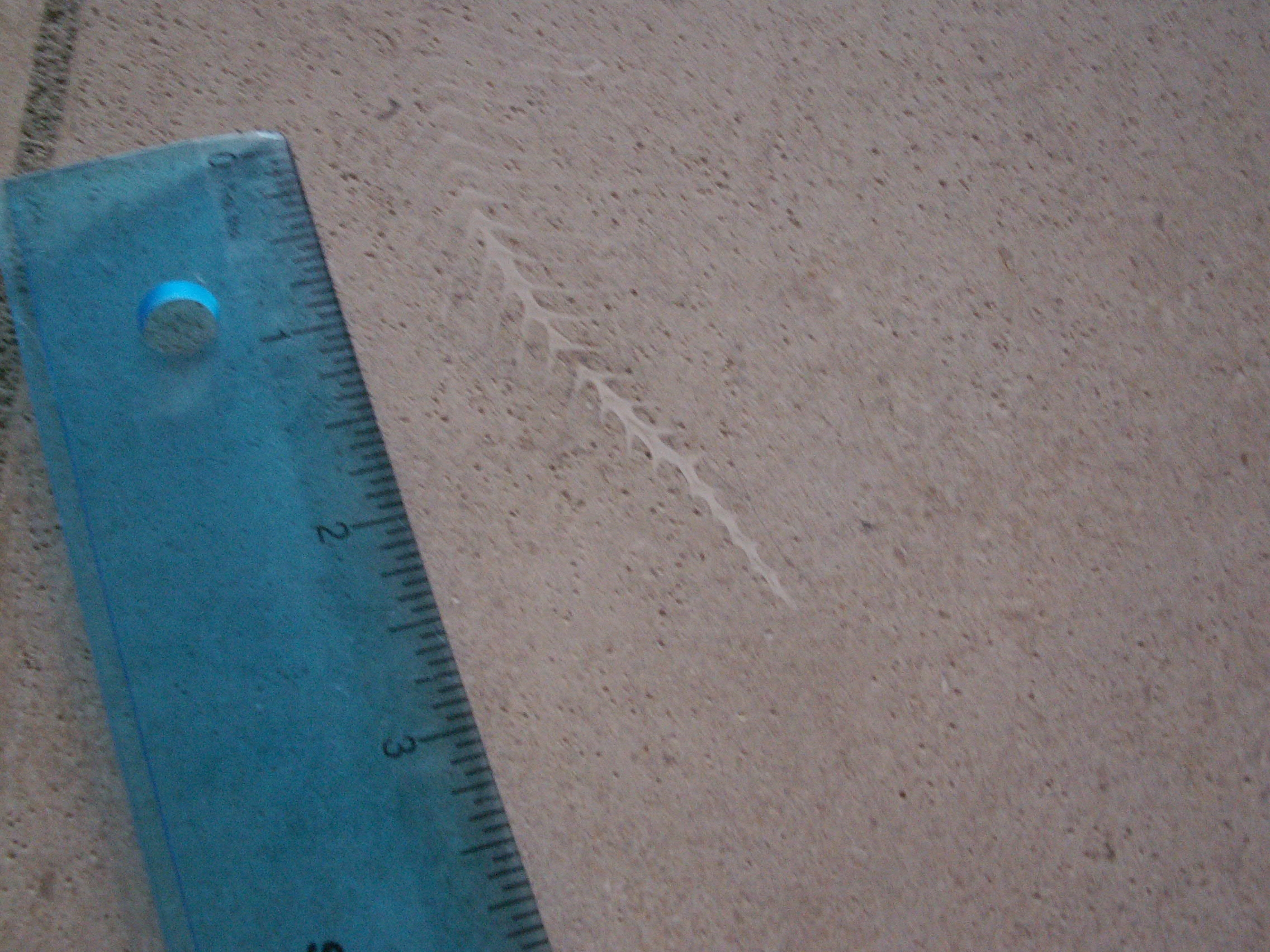
The fossil is a bryozoan known as Archimedes, and it is present because the white stone interior walls here and elsewhere in the building are made of the Bangor Limestone, which first accumulated as seafloor sediment during the Elvirian epoch of the Mississippian period, approximately 325 million years ago. These limestone panels in the museum are composed of masses of calcium-based skeletons from shallow marine dwelling animals, long since compressed and lithified into stone. The wonderful detail in the fossil above is, unfortunately, an uncommon find in the National Gallery of Art; fossils that are visible to the unaided eye are widely scattered and somewhat difficult to locate. The Bangor Limestone nonetheless provides an interesting window into Alabama during a very different time – and an interesting lesson in comparing different types of limestones.
The Fossils
Visible fossils in this portion of the Bangor Limestone are infrequent and are most easily recognized as dark grey lines appearing in the white matrix of the stone. Two typical examples follow.
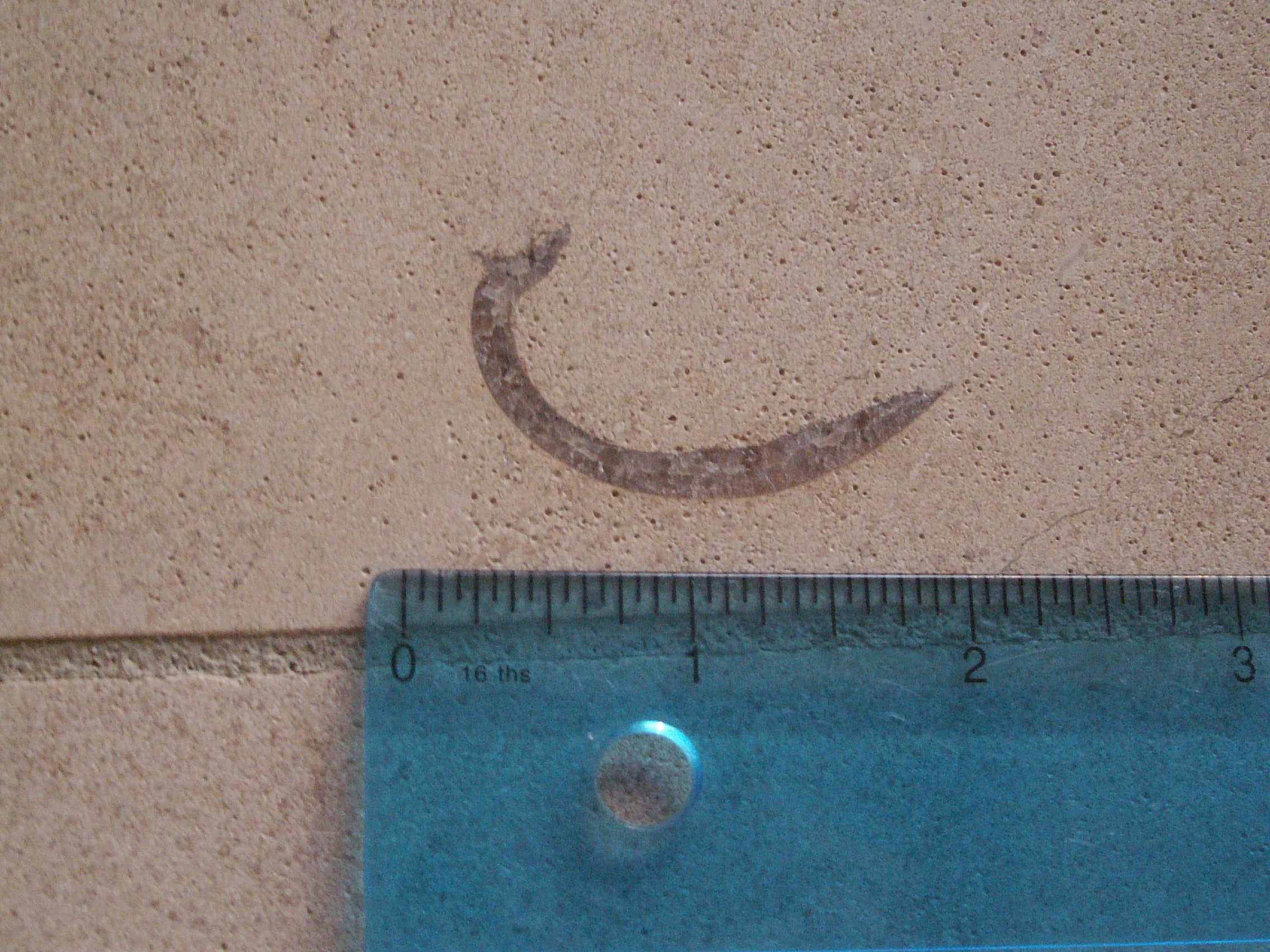
The photo above appears to show a large, though partial, cross-section of a bivalve shell, with the hinge appearing at the left. It is difficult to determine whether the shell is from a brachiopod (brachiopods are discussed in detail in Gallery 5) or a pelecypod (similar to modern clams).
The fossil in the next picture is large but not entirely clear:
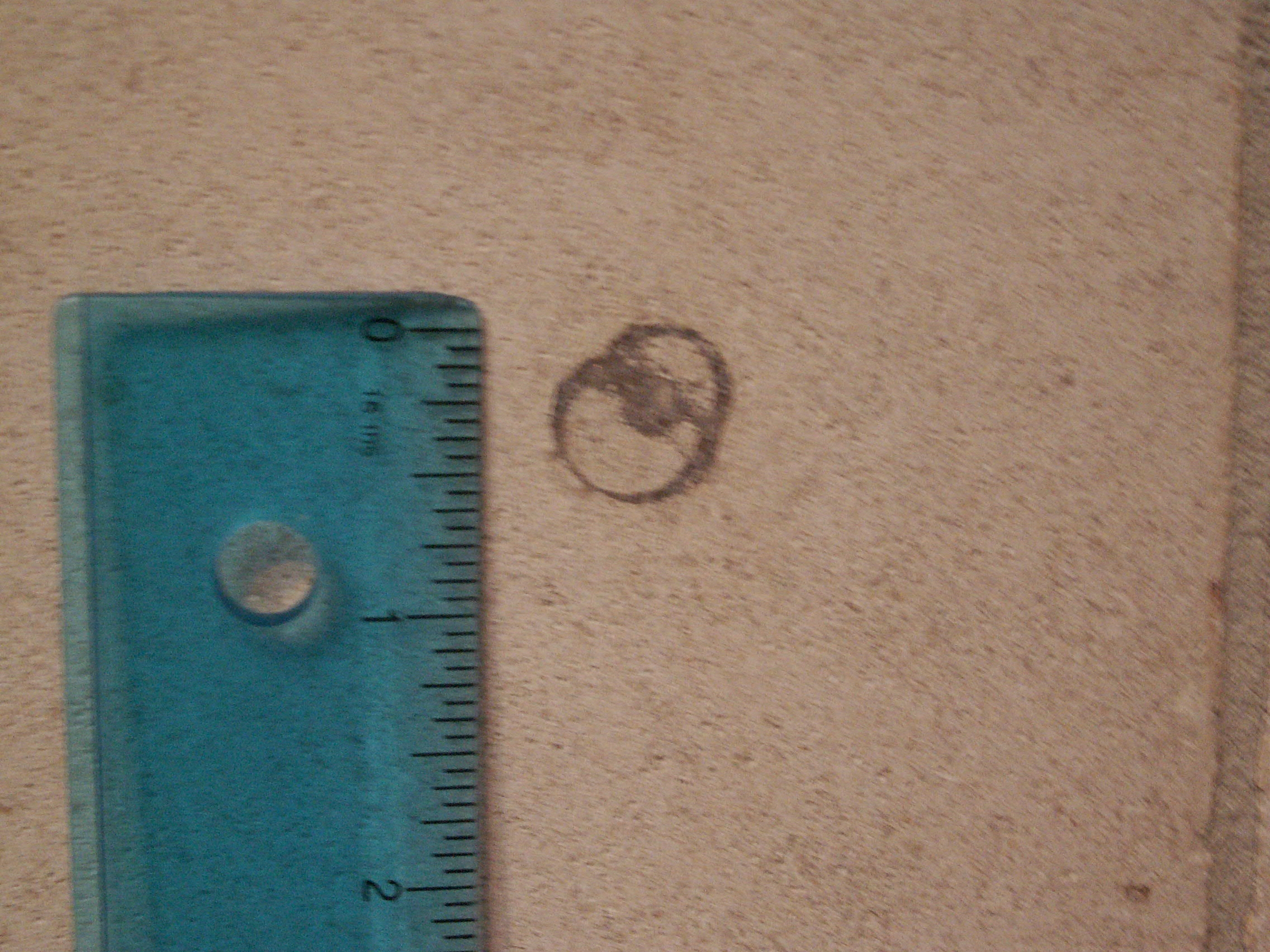
This fossil above appears to be a cross-section of a gastropod shell, at a slanted or oblique angle. The occupant of such a shell would have been related to modern marine molluscs.
Taking another look at the Archimedes near Hadrian’s bust, this specimen offers excellent detail:
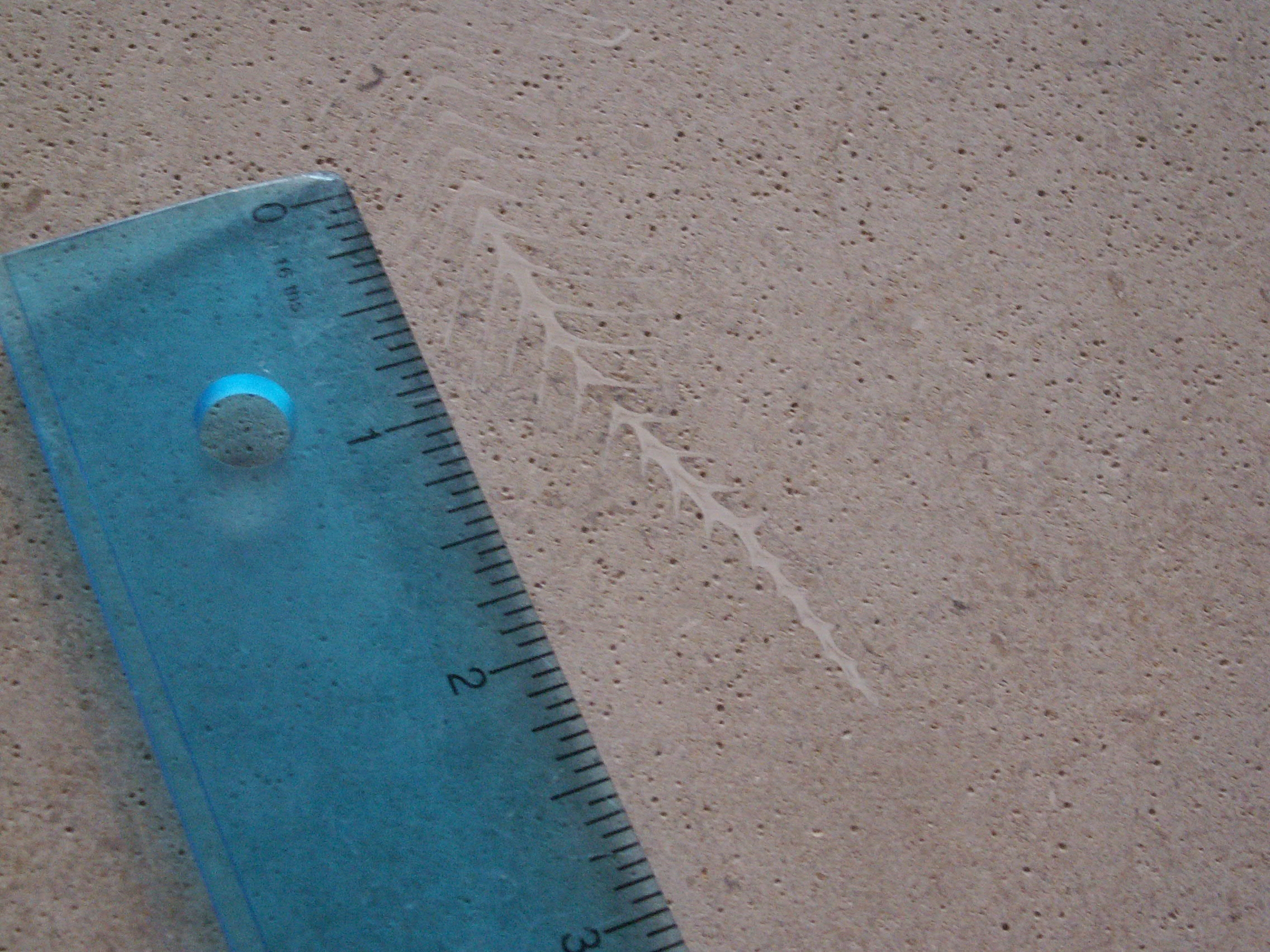
As a bryozoan, Archimedes somewhat resembled in outward form types of modern corals, and like corals consisted of a large calcareous structure housing many separate, tiny animals. However, bryozoans (Greek for “moss animals”) were not related to corals and differ from them in many respects. Details about the bryozoans are described in Gallery 6. A modern visualization of bryozoans as they may have appeared during the Ordovcian may be seen in the Smithsonian’s Ordovician diorama. (See Gallery 3)
As do other limestone formations, different portions of the Bangor Limestone contain different types and quantities of visible fossils. Another portion of the Bangor Limestone, not used to quarry this stone, differs in composition, as this photograph shows:
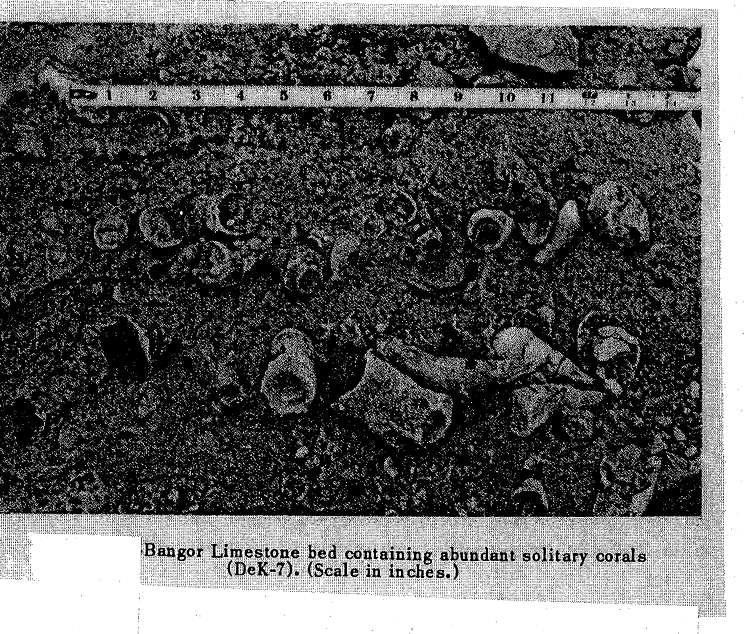
Source: Figure 18, p. 52, Mississippian Stratigraphy, cited below, courtesy of the Geological Survey of Alabama.
For purposes of building stone, however, the fine-grained stone in this museum, with only occasional fossils, was a more likely candidate for use as a building stone than the bed rich in large corals shown above.
Nature and Paleoenvironment of the Bangor Limestone
Structure
The Bangor Limestone (named after the town of Bangor in Blount County, Georgia) is composed of a series of limestones that differ in composition (as the pictures above suggest). It is primarily bioclastic (masses of skeletal fossils cemented together with calcareous cement) and oolitic (composed of spherical grains of calcium cemented together). Overall, the Bangor Limestone is more than 500 feet thick (up to 700 feet in places), and its surface exposures form a band trending from Franklin County in northwest Alabama southeast into Walker County. During the late Mississippian period, the area that is now the state of Alabama was close to the equator, covered with warm, shallow seas, possibly very similar to conditions off the Florida Keys and Bahamas of today. A rich marine ecosystem thrived on the shoals and sea floor, consisting of a wide variety of marine animals, including crinoids, blastoids, brachiopods, bryozoans and corals. As they died, their hard calcium-rich skeletal remains were fragmented into a kind of sand, moved and sorted by waves and currents – evidence suggests that this was an agitated marine environment, not a quiet one. The process by which these calcium-based sands became limestone rocks is described in Gallery 6.
Limestone Identification in Blue and Gray
Distinguishing one type of limestone from another can be quite difficult. Two blocks of limestone may look different, yet be cut from different portions of the same quarry. Different levels or areas of a single limestone formation will often differ in texture and even fossil distribution. A positive identification often requires detailed analysis.
The Bangor Limestone offers a most interesting case study – an effort with echoes of the Civil War, aided by modern microscopic analysis.
The question arose during the restoration of the Confederate Monument in Montgomery, Alabama. Originally built between 1886 and 1898, using in part Bangor Limestone from the Russelville quarry, the Monument was dedicated to those who fought for Alabama during the Civil War.
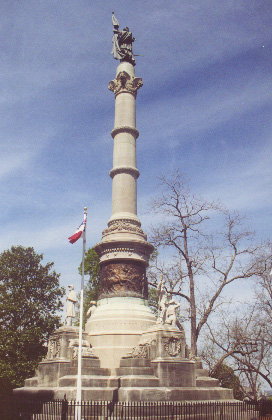
Source: http://www.conservationsolution.com/work_casestudies_alabama_confederate_monument.html (used with permission of McKay Lodge Conservation Laboratory, Inc.)
In 2000, under the direction of the Alabama Historical Commission, a study was undertaken to determine the history, materials, structure and condition of the monument. To their surprise, the researchers found that the lower and upper sections of the monument appeared to contain two different types of limestone. According to the records, the limestone was from the Russellville quarry in Franklin County, Alabama – the Bangor Limestone. The lower section’s limestone was grey – characteristic of the Bangor Limestone – but the upper portion was tan. Its color appeared similar to that of the other major source of limestone then and now – Indiana. Conclusive identification of the stones could not be done on the basis of superficial appearance alone. The mystery of the upper stone went beyond the practical issues of restoration, however. As one author wrote:
“Since the monument was created to commemorate the patriotism of those who fought for the Confederacy, one would assume that every effort would have been made to only use stone from states that banded together in the Confederacy to protect states rights. The quarry in Alabama produced then, in the 19th century, and is still producing today, the finest of limestone. Why turn elsewhere for stone?”
Sculpture Conservation, cited below, at 1.
Was the stone in the Confederate memorial in fact from a Union state?
To answer that question, the researchers turned to microscopic studies of “thin sections” (very thin slices of rock which can be viewed under a microscope), comparing both samples from the upper and lower sections of the monument, as well as samples from the Russellville and Indiana quarries. The thin sections revealed dramatically different details as to the crystalline structure of the limestones.
Both the Alabama and Indiana Limestones were deposited as a mass of densely packed skeletal fragments of creatures from a shallow marine environment during the Mississippian period, under roughly similar conditions (though separated in time by 20-30 million years). Both became stone as calcium rich cements formed crystals in the pores between the fossil fragments. However, the Indiana Limestone had a much, much higher percentage of crinoid fragments than the Alabama limestone, which was richer in bryozoans, corals and clams. Because of the crystal structure of crinoids, whose skeletal “shells” consist of an interlocking mosaic of large crystals, the crystals forming in the pores between the crinoid fragments would grow as large, clear crystals as well. In contrast, the cements crystallizing in the pores between the fossil fragments in the Alabama limestone formed in many tiny crystals. The result can be clearly seen under a microscope, as the images below illustrate.
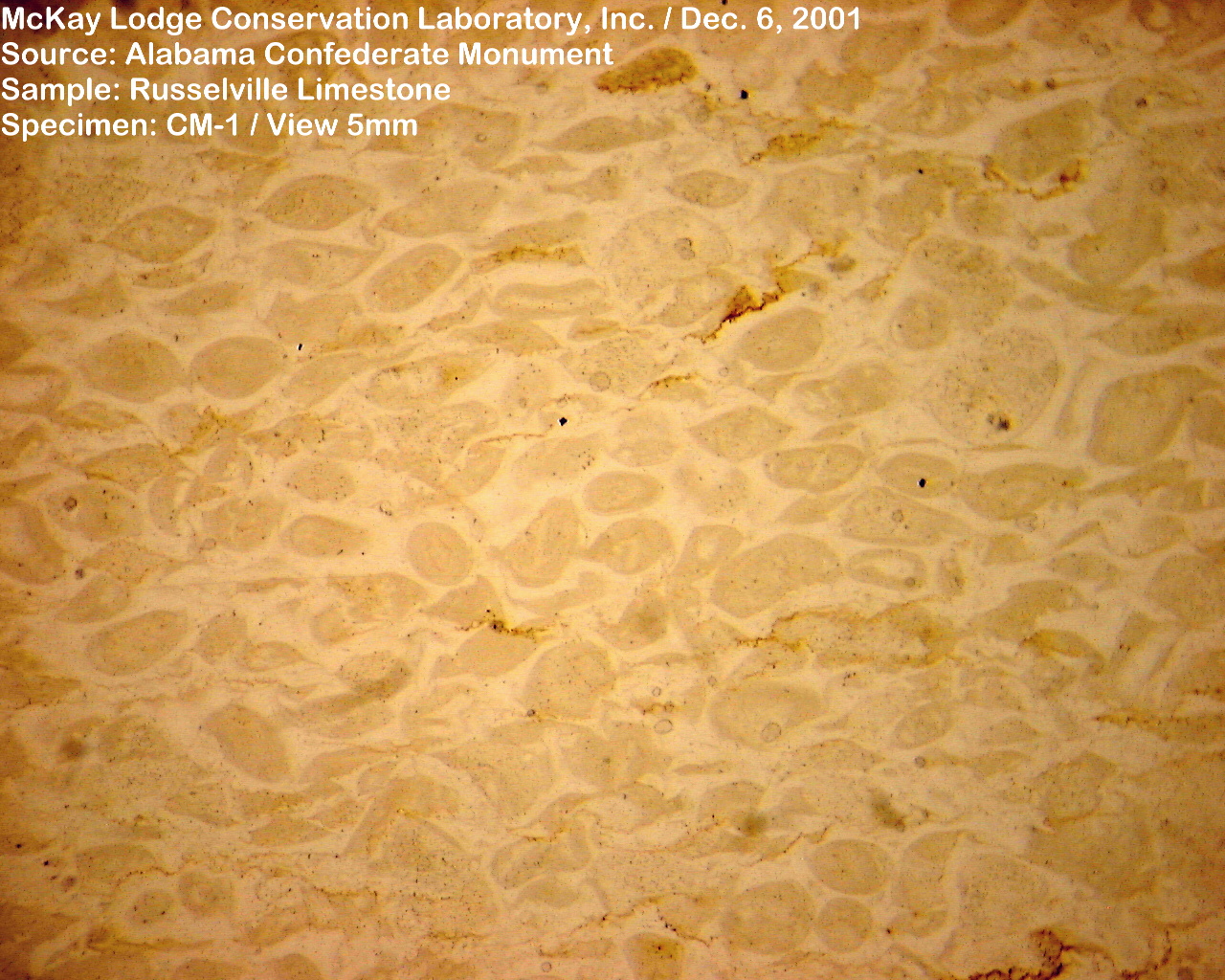
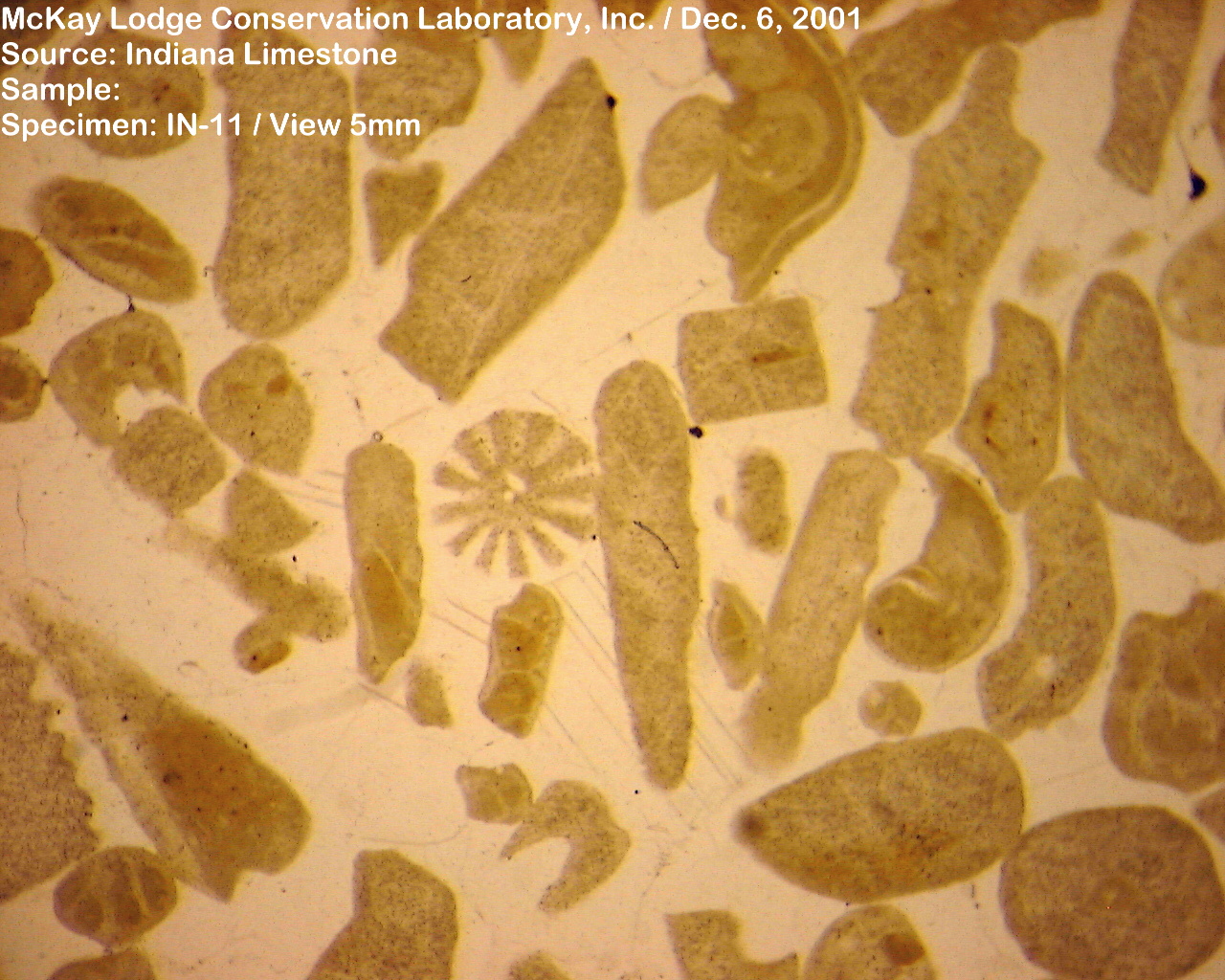
(Used with permission of McKay Lodge Conservation Laboratory, Inc.)
The pores between fossil fragments shown in CM-1 (Alabama limestone) show crowded masses of crystals. The pores between fragments in IN-11 (Indiana Limestone) show large, clear crystals between the fragments. The microscopic analysis therefore appears to confirm the conclusion based on unaided eyesight, that the upper section of the monument came from Indiana. The researchers acknowledged that even that determination was not 100% conclusive, given the variations that occur within limestone formations.
Several years after the research was performed, the organization overseeing the restoration received a communication from an instructor at a community college in northwestern Alabama stating that the upper monument was known by local people to have been quarried from a place near the main source of the Bangor Limestone.
Despite geologists’ best efforts to interpret the crystalline differences among two limestone samples, positive identification remains elusive.
Ordovician Fossils
The third fossil exhibit at the National Gallery of Art occurs in two unlikely places. For the convenience of visitors spending long hours viewing its collection, the museum provides restrooms on both the ground floor and the main floor. Be certain to visit one of the restrooms on the main floor, just north of the Rotunda. Inside, the walls feature a polished black stone, shot throughout with white shapes. Take a close look and you will see straight-shelled nautiloids (related to the Holston Formation nautiloids nearby in the floor), crinoid segments, large snail shells, and more.
This stone is called by the trade names, “Champlain Black Marble” or “Radio Black Marble.” It was quarried from the Crown Point Formation, on Isle LaMotte, Vermont. Its original sediments were deposited during the Ordovician, and its fossils form a record of the earliest reefs on which corals grew, approximately 480 million years ago. A detailed discussion of the formation and its paleoenvironment is found in Gallery 3, which appears to have the largest display of the Crown Point Formation in the city. Interestingly, the types of visible fossils common in this stone in the National Gallery of Art differ from those in the Arts and Industries Building, suggesting that they were quarried from different portions of the Crown Point Formation, possibly representing different depositional environments.
Acknowledgments and Sources[1]
Holston Formation
Identification of the fossils. The archives of the National Gallery of Art listed the stone as being “Fantasia Rose,” apparently an obsolete trade name. The records also stated that that the stone was from Tennessee. The Tennessee Geological Survey reviewed pictures of the stone and concluded that it was from the Holston Formation, and provided a suggestion as to the identity of the nautiloids.
Information about the building and its architect’s goals is from The National Gallery of Art, by John Walker (1975) at 23-26 (providing all quotes and most information about the purpose and nature of the architecture), and Washington Itself, An Informal Guide to the Capital of the United States, by E.J. Applewhite (1991 ed.), at 171-179 (noting the 40 quarries and the relatively empty nature of the museum upon opening); see also A Guide to the Architecture of Washington, D.C., The American Institute of Architects [check] (1965) at 43.
Information about the fossils and paleoecology is from personal communication, from Barry Miller, Tennessee Division of Geology, and from Bulletin 28, Marble Deposits of East Tennessee, C.H. Gordon, T. Nelson Dale, et al., State of Tennessee Dept. of Education, Division of Geology (1924).
Bangor Limestone
Identification. The USGS’ Building Stones of Our Nation’s Capital notes the presence in the National Gallery of Art of fossil-bearing limestone from Alabama (although the county of origin is not Colbert County as noted by USGS, but nearby Franklin County). Identification of the geologic formation and fossils, as well as the sources noted below and other information was generously provided by Edward Osborne and Dean Lewis of the Geological Survey of Alabama.
Bangor Formation. Mississippian Stratigraphy of Alabama, by William A. Thomas, Monograph 12, Geological Survey of Alabama (1972).
Paleoecology Nonfenestrate Ectoprocta (Bryozoa) of the Bangor Limestone of Alabama, by Frank K. McKinney, Bulletin 98, Geological Survey of Alabama (1972). Sculpture Conservation: About the Limestone Thin Sections, by the McKay Lodge Fine Arts Conservation Laboratory, Inc. (2002), athttp://www.sculptureconservation.com/limestone.html
Limestone identification issues raised by Alabama’s Confederate Monument. The discussion in under the heading, “Limestone Identification in Blue and Grey” is drawn entirely from two related works, “The Confederate Monument Preservation Assessment,” by McKay Lodge Conservation Laboratory, Inc., athttp://www.mckaylodge.com/monument.html; Sculpture Conservation: About the Limestone Thin Sections, by the McKay Lodge Fine Arts Conservation Laboratory, Inc. (2002), athttp://www.sculptureconservation.com/limestone.html The McKay Lodge organization has generously consented to the reproduction of the photographs used in connection with the Confederate Monument discussion and provided very useful information. Mr. Jim Bonner of the Northwest Shoals Community College sent in the contrary view that the Confederate Monument limestone was from the Reid Brothers quarry, ten miles from the Rockwood quarry, that provided much of the period Alabama limestone.
[1] Where this website cites specific internet page addresses, they are typically the addresses used by the author in researching and writing this discussion – a process taking several years. Unfortunately, in the meantime a number of the specific addresses have changed, and will continue to change, rendering some of these addresses ineffective as links. Readers should be able to find the material by searching for the proper name of the cited article or material on a search engine.
